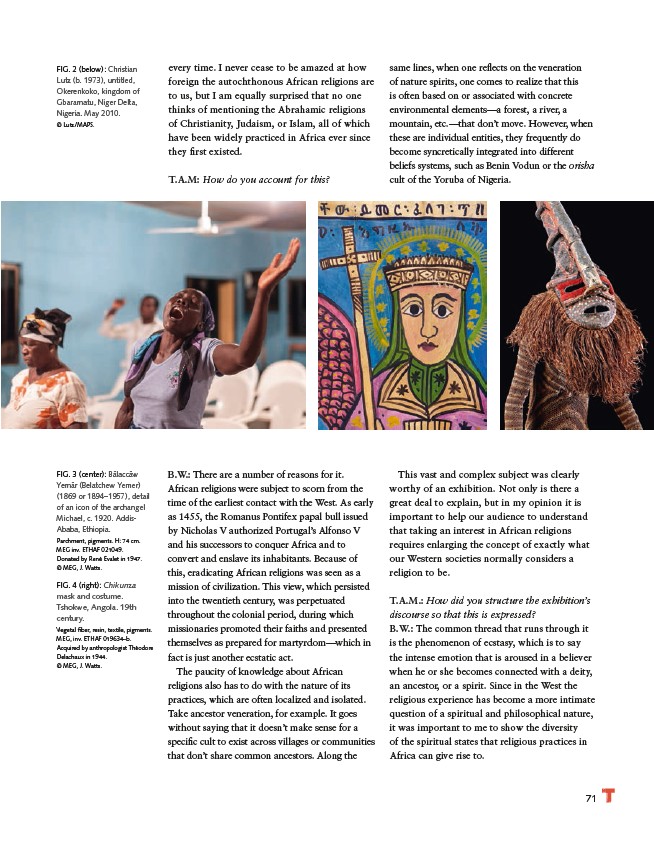
71
every time. I never cease to be amazed at how
foreign the autochthonous African religions are
to us, but I am equally surprised that no one
thinks of mentioning the Abrahamic religions
of Christianity, Judaism, or Islam, all of which
have been widely practiced in Africa ever since
they first existed.
T.A.M: How do you account for this?
B.W.: There are a number of reasons for it.
African religions were subject to scorn from the
time of the earliest contact with the West. As early
as 1455, the Romanus Pontifex papal bull issued
by Nicholas V authorized Portugal’s Alfonso V
and his successors to conquer Africa and to
convert and enslave its inhabitants. Because of
this, eradicating African religions was seen as a
mission of civilization. This view, which persisted
into the twentieth century, was perpetuated
throughout the colonial period, during which
missionaries promoted their faiths and presented
themselves as prepared for martyrdom—which in
fact is just another ecstatic act.
The paucity of knowledge about African
religions also has to do with the nature of its
practices, which are often localized and isolated.
Take ancestor veneration, for example. It goes
without saying that it doesn’t make sense for a
specific cult to exist across villages or communities
that don’t share common ancestors. Along the
same lines, when one reflects on the veneration
of nature spirits, one comes to realize that this
is often based on or associated with concrete
environmental elements—a forest, a river, a
mountain, etc.—that don’t move. However, when
these are individual entities, they frequently do
become syncretically integrated into different
beliefs systems, such as Benin Vodun or the orisha
cult of the Yoruba of Nigeria.
This vast and complex subject was clearly
worthy of an exhibition. Not only is there a
great deal to explain, but in my opinion it is
important to help our audience to understand
that taking an interest in African religions
requires enlarging the concept of exactly what
our Western societies normally considers a
religion to be.
T.A.M.: How did you structure the exhibition’s
discourse so that this is expressed?
B.W.: The common thread that runs through it
is the phenomenon of ecstasy, which is to say
the intense emotion that is aroused in a believer
when he or she becomes connected with a deity,
an ancestor, or a spirit. Since in the West the
religious experience has become a more intimate
question of a spiritual and philosophical nature,
it was important to me to show the diversity
of the spiritual states that religious practices in
Africa can give rise to.
FIG. 2 (below): Christian
Lutz (b. 1973), untitled,
Okerenkoko, kingdom of
Gbaramatu, Niger Delta,
Nigeria. May 2010.
© Lutz/MAPS.
FIG. 3 (center): Bälaccäw
Yemär (Belatchew Yemer)
(1869 or 1894–1957), detail
of an icon of the archangel
Michael, c. 1920. Addis-
Ababa, Ethiopia.
Parchment, pigments. H: 74 cm.
MEG inv. ETHAF 021049.
Donated by René Évalet in 1947.
© MEG, J. Watts.
FIG. 4 (right): Chikunza
mask and costume.
Tshokwe, Angola. 19th
century.
Vegetal fiber, resin, textile, pigments.
MEG, inv. ETHAF 019634–b.
Acquired by anthropologist Théodore
Delachaux in 1944.
© MEG, J. Watts.